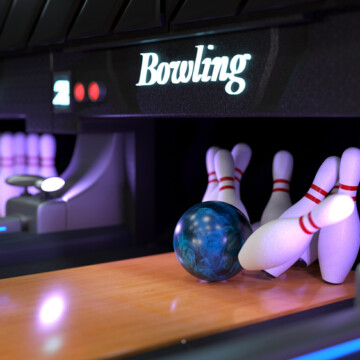
Whether you're a seasoned bowler or just getting started, joining a bowling team can be a great way to test your skills.
But before you can start enjoying the benefits of being on a team, you need to know about bowling team positions. In case you weren't aware, these positions are more important than you think.
In this article, we'll tell you all you need to know about bowling team positions and responsibilities.
Contents
Bowling Team Positions and Roles
Unless you’ve bowled regularly or on a team before, you might not have realized that bowling often involves team play. This dynamic dictates that each team is divided into specific positions.
The consensus is to start by rating players from best to the worst bowler. Typical positions include:
- First Position: This player is also referred to as “the table setter,” meaning their job is to set the team up for a good start. Typically, the first bowler is the third-best bowler on the team.
- Second Position: This position is reserved for the "greenest" player on the team. The reason why is that there are three more teammates who can help to bump up the score as needed. Though this is the case, the second position still plays an important role. Every point counts.
- Third Position: If you're in the third position, you're someone who has the potential to elevate the team’s score, though you may not be the best on the team. This player might be newer and lack experience, but their growth and contribution to the team are still valued. As with the second position, the team can help boost a low score if the third position player has a bad frame.
- Fourth Position: You’ll want to place a pretty consistent bowler in the fourth position. Sometimes referred to as the “setup man,” this player has proven to be consistent with good scores.
- Fifth Position: Another term for the fifth position refers to this player as an “anchor” for the team. This will typically be the best player on the team who can perform at an exceptional level on demand and is mentally strong. The expectation is these are the best bowlers and will consistently deliver strikes.
Many times, teams are put together according to a player’s average score. Some people prefer to use the average score of a particular player while considering individual strengths and weaknesses.
The team selection process isn’t a popularity contest and, if it were to be treated as such, could create a weak, underperforming team. Remember that if someone wants you on their team, it’s because they feel you deserve a spot on it.

Choosing and Creating Your Bowling Team
Before you assign people positions, you have to have a team ready to go. When you select the players for your team, you’ll want to keep in mind the unique skill and potential of each player.
Even if you’re forming a team with family, friends, or co-workers, it’s still important to consider everyone’s strengths. You may also want to have people try out for specific positions.
Most bowling leagues consist of between three and five players, with five person bowling team being the most common for competitive team bowling. The five-person team is the maximum number set by the USBC (United States Bowling Congress).

10 Strategies for Bowling Teams
Just because each person on a bowling team was selected specifically for how they play and what they’ll contribute, it doesn’t mean that you won't work together on a strategy.
When everyone knows the goals and expectations of all players involved, it'll be easier to rack up those points. Here are some strategies other teams have found to be helpful:
- Focus on winning against your counterpart. You can only control your bowl. When you break your game down to a one-on-one battle, it can help you to focus more on what you need to do.
- Pay attention to your overall team performance. If one player is performing poorly, you’ll have to aim higher than simply beating the score of your counterpart.
- Cheer on your teammates even if they’re bowling a poor game. Positive vibes can go a long way when things aren't going as planned.
- Set a goal for a percentage of matches you want to win in a season. Having a goal to strive for will help to keep you motivated.
- Decide if you want to practice together, as individuals, or both. Practicing together builds a sense of camaraderie and can help you to learn each other’s strengths and weaknesses. Individual practice, on the other hand, is an excellent way to work on specific weaknesses or skills that need refinement. A mixture of both could be ideal.
- Don't play on a team with someone who isn't team-minded. This person is not suited to play in a group setting and could drag the rest of the team down into a losing position. It's best to find someone who is supportive and willing to work together toward a common goal.
- Pay attention to the game's pace. Your team's pace should be in line with that of your opponent. Some tournaments have a rule that if you slow-bowl, you forfeit the game.
- Have backup players in mind if you ever have a team member who needs replacing. This may become necessary if a player repeatedly misses games or chooses to bow out of their commitment. Make sure you know your league’s rules regarding substitutes and new bowlers.
- Give and take criticism and help. Be ready to help struggling players with constructive and helpful details about their performance. If you suspect they aren’t using the right equipment for the game or that their approach or swing is off, speak up. You should also be open to accepting help from other team members. You’re all in it together.
- Don’t forget to include all of your team members in practices, meetings, and even social events. Your bowling team is a fully functioning unit. Investing some time outside of competitions can help form stronger bonds.
Bowling Team Responsibilities
Your bowling team will likely have its own “manager” or point person. And it’s easy for players to put all responsibility on the one they perceive is in charge.
Our advice is to avoid relying on your team leader for everything. Offer to help and take on roles that clearly aren’t that person's responsibility. This might mean you clean up your playing area after all your teammates have left.
While you didn’t sign up to clean up after others, you're taking on a task that would have otherwise fallen on the leader’s already heavy plate.
Bowling is a sport built on etiquette.
As a team member, make sure you’re upholding the values of the game. This includes being on time for your matches and not purposely distracting your opponents.
It also means being a good sport when you lose and congratulating your opponents when they win. No one likes a sore loser.
If you’re a beginner, you may need some help understanding all the rules of the game. But that doesn’t mean you shouldn’t put in the effort to understand as much as you can.
At the very least, you should know the scoring system and how to properly throw a ball. The more you know, the more you can help your team.

Related Articles
So, there you have it - all you need to know about bowling team positions. Whether you're starting a team of your own or joining an existing one, understanding the different roles is essential for success.
If you are chosen to play position two or three, don't be discouraged - you're still an integral part of the team. Remember, it takes all positions working together to make a winning team.
We encourage you to continue working on your bowling skills and to always strive to improve your game. Who knows? Maybe next season, you'll be the one in position one. Good luck!
Kira Byrd, a Certified Fraud Examiner, holds a B.S. in Accounting from the University of Alabama at Birmingham. With a passion for bowling from her childhood, Kira has poured her expertise and personal experiences into creating and nurturing Bowling For Beginners. Kira's mission is to meet new bowlers where they are and guide them toward consistently achieving higher scores. With a focus on skill development and strategic techniques, she empowers readers to take control of their game and unlock their true potential.
Bowling For Beginners embodies strict editorial integrity, ensuring reliable and unbiased information. Kira's commitment to delivering valuable insights and practical strategies is reflected in every article. Here's an explanation of our editorial policy and how we get money.





